Public Private Partnerships in Australian International Constructions
VerifiedAdded on 2023/06/04
|19
|5440
|488
Report
AI Summary
This report evaluates the concept of Public Private Partnerships (PPP) within the Australian context, examining the national policy framework and comparing its application in developed and developing countries. It highlights the increasing adoption of PPP in both sectors due to its numerous advantages, focusing on its role in infrastructure development. The report discusses various PPP models, including social and economic infrastructure PPPs, and their implementation in Australia and the United States. It also addresses the risks associated with PPP projects, such as financial burdens on private partners and potential inflexibility. The analysis emphasizes the importance of PPP in delivering timely and efficient public services, resource management, and project completion within budget, while also acknowledging potential disadvantages like high transaction costs. The report concludes by underscoring the necessity for PPP models to evolve and provide better value to governments, particularly in infrastructure projects where traditional procurement methods may be less effective. Desklib offers students access to this report and many other solved assignments.

Running head: INTERNATIONAL CONSTRUCTIONS
International constructions
Name of the Student
Name of the University
Author Note
International constructions
Name of the Student
Name of the University
Author Note
Paraphrase This Document
Need a fresh take? Get an instant paraphrase of this document with our AI Paraphraser
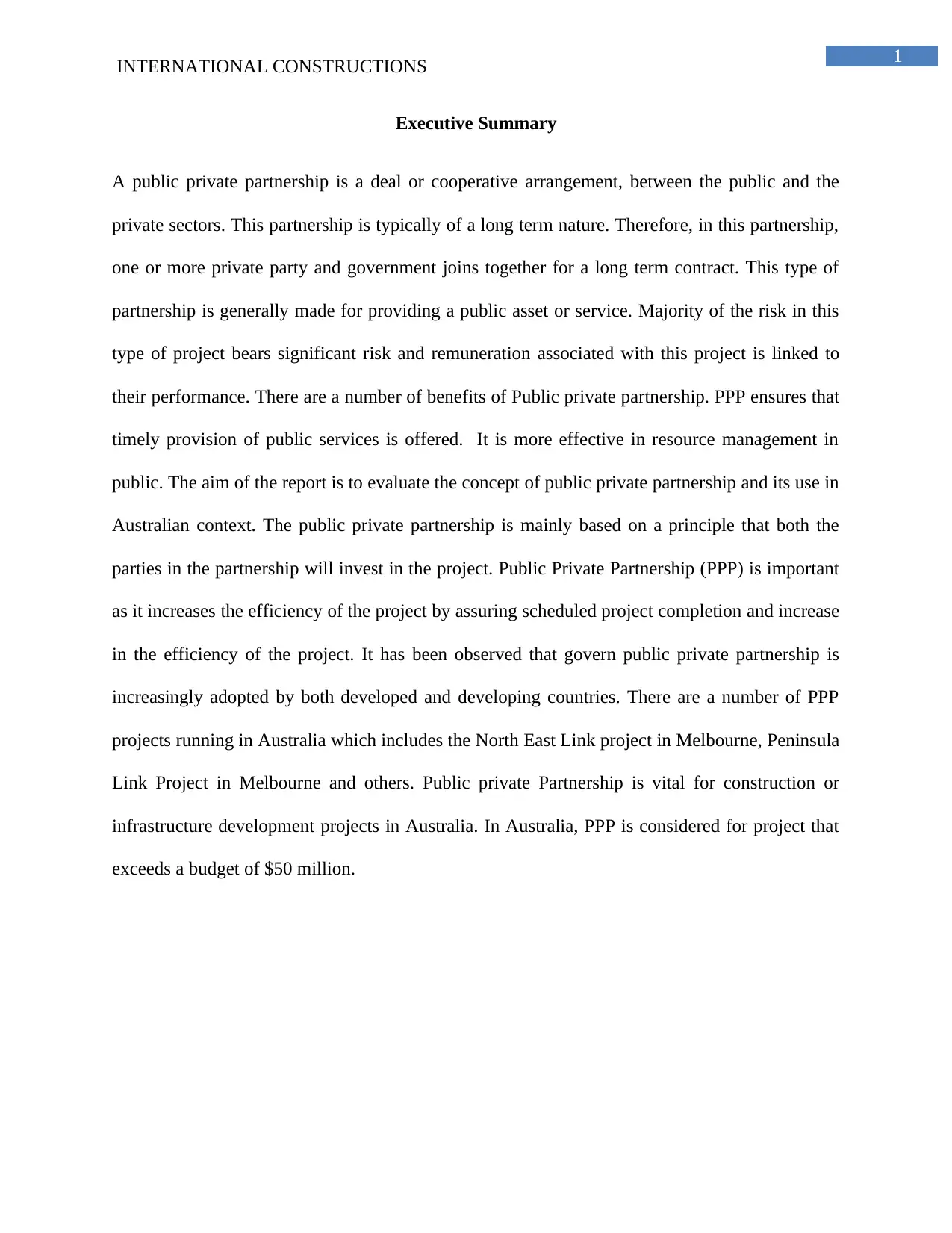
1
INTERNATIONAL CONSTRUCTIONS
Executive Summary
A public private partnership is a deal or cooperative arrangement, between the public and the
private sectors. This partnership is typically of a long term nature. Therefore, in this partnership,
one or more private party and government joins together for a long term contract. This type of
partnership is generally made for providing a public asset or service. Majority of the risk in this
type of project bears significant risk and remuneration associated with this project is linked to
their performance. There are a number of benefits of Public private partnership. PPP ensures that
timely provision of public services is offered. It is more effective in resource management in
public. The aim of the report is to evaluate the concept of public private partnership and its use in
Australian context. The public private partnership is mainly based on a principle that both the
parties in the partnership will invest in the project. Public Private Partnership (PPP) is important
as it increases the efficiency of the project by assuring scheduled project completion and increase
in the efficiency of the project. It has been observed that govern public private partnership is
increasingly adopted by both developed and developing countries. There are a number of PPP
projects running in Australia which includes the North East Link project in Melbourne, Peninsula
Link Project in Melbourne and others. Public private Partnership is vital for construction or
infrastructure development projects in Australia. In Australia, PPP is considered for project that
exceeds a budget of $50 million.
INTERNATIONAL CONSTRUCTIONS
Executive Summary
A public private partnership is a deal or cooperative arrangement, between the public and the
private sectors. This partnership is typically of a long term nature. Therefore, in this partnership,
one or more private party and government joins together for a long term contract. This type of
partnership is generally made for providing a public asset or service. Majority of the risk in this
type of project bears significant risk and remuneration associated with this project is linked to
their performance. There are a number of benefits of Public private partnership. PPP ensures that
timely provision of public services is offered. It is more effective in resource management in
public. The aim of the report is to evaluate the concept of public private partnership and its use in
Australian context. The public private partnership is mainly based on a principle that both the
parties in the partnership will invest in the project. Public Private Partnership (PPP) is important
as it increases the efficiency of the project by assuring scheduled project completion and increase
in the efficiency of the project. It has been observed that govern public private partnership is
increasingly adopted by both developed and developing countries. There are a number of PPP
projects running in Australia which includes the North East Link project in Melbourne, Peninsula
Link Project in Melbourne and others. Public private Partnership is vital for construction or
infrastructure development projects in Australia. In Australia, PPP is considered for project that
exceeds a budget of $50 million.
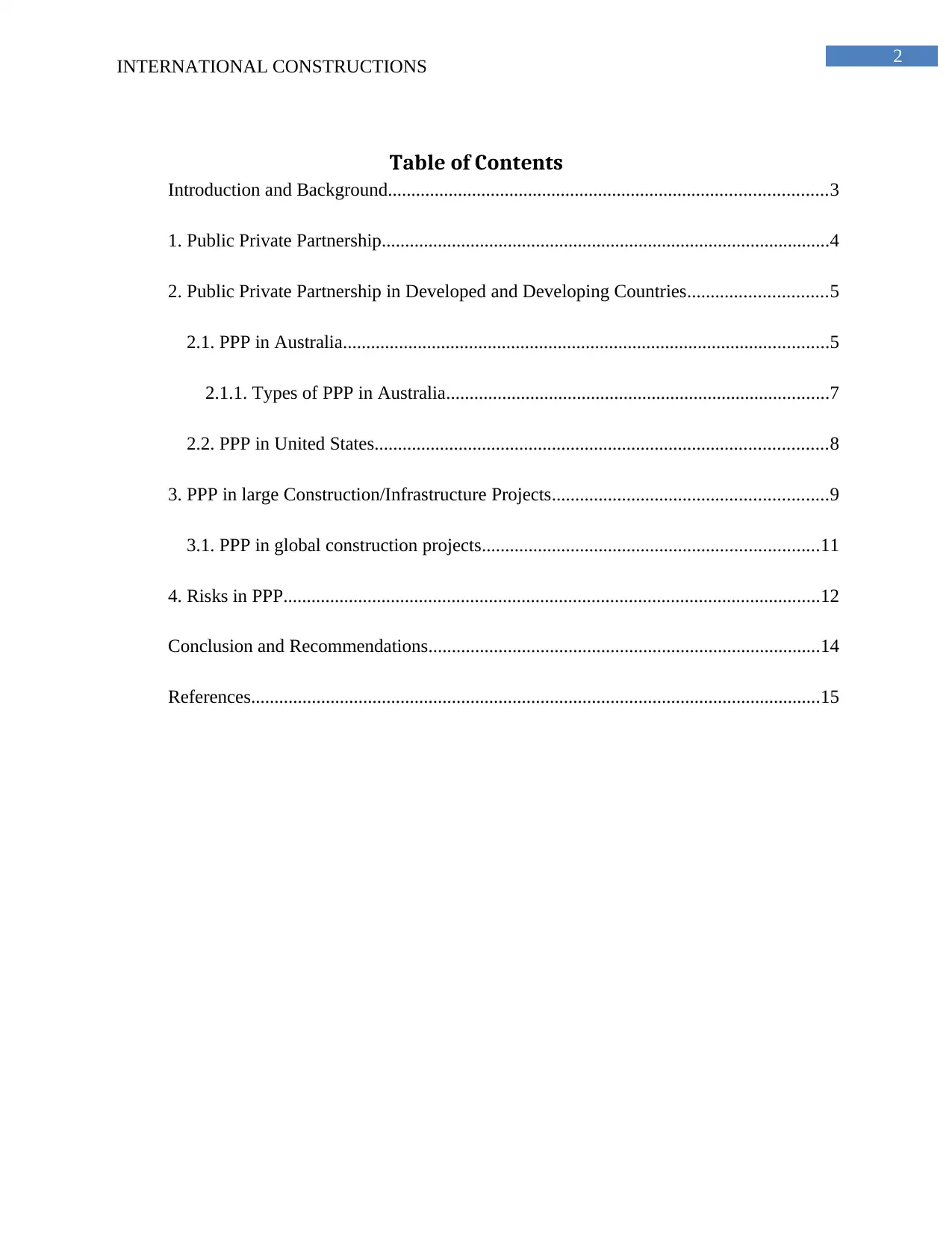
2
INTERNATIONAL CONSTRUCTIONS
Table of Contents
Introduction and Background..............................................................................................3
1. Public Private Partnership................................................................................................4
2. Public Private Partnership in Developed and Developing Countries..............................5
2.1. PPP in Australia........................................................................................................5
2.1.1. Types of PPP in Australia..................................................................................7
2.2. PPP in United States.................................................................................................8
3. PPP in large Construction/Infrastructure Projects...........................................................9
3.1. PPP in global construction projects........................................................................11
4. Risks in PPP...................................................................................................................12
Conclusion and Recommendations....................................................................................14
References..........................................................................................................................15
INTERNATIONAL CONSTRUCTIONS
Table of Contents
Introduction and Background..............................................................................................3
1. Public Private Partnership................................................................................................4
2. Public Private Partnership in Developed and Developing Countries..............................5
2.1. PPP in Australia........................................................................................................5
2.1.1. Types of PPP in Australia..................................................................................7
2.2. PPP in United States.................................................................................................8
3. PPP in large Construction/Infrastructure Projects...........................................................9
3.1. PPP in global construction projects........................................................................11
4. Risks in PPP...................................................................................................................12
Conclusion and Recommendations....................................................................................14
References..........................................................................................................................15
⊘ This is a preview!⊘
Do you want full access?
Subscribe today to unlock all pages.

Trusted by 1+ million students worldwide
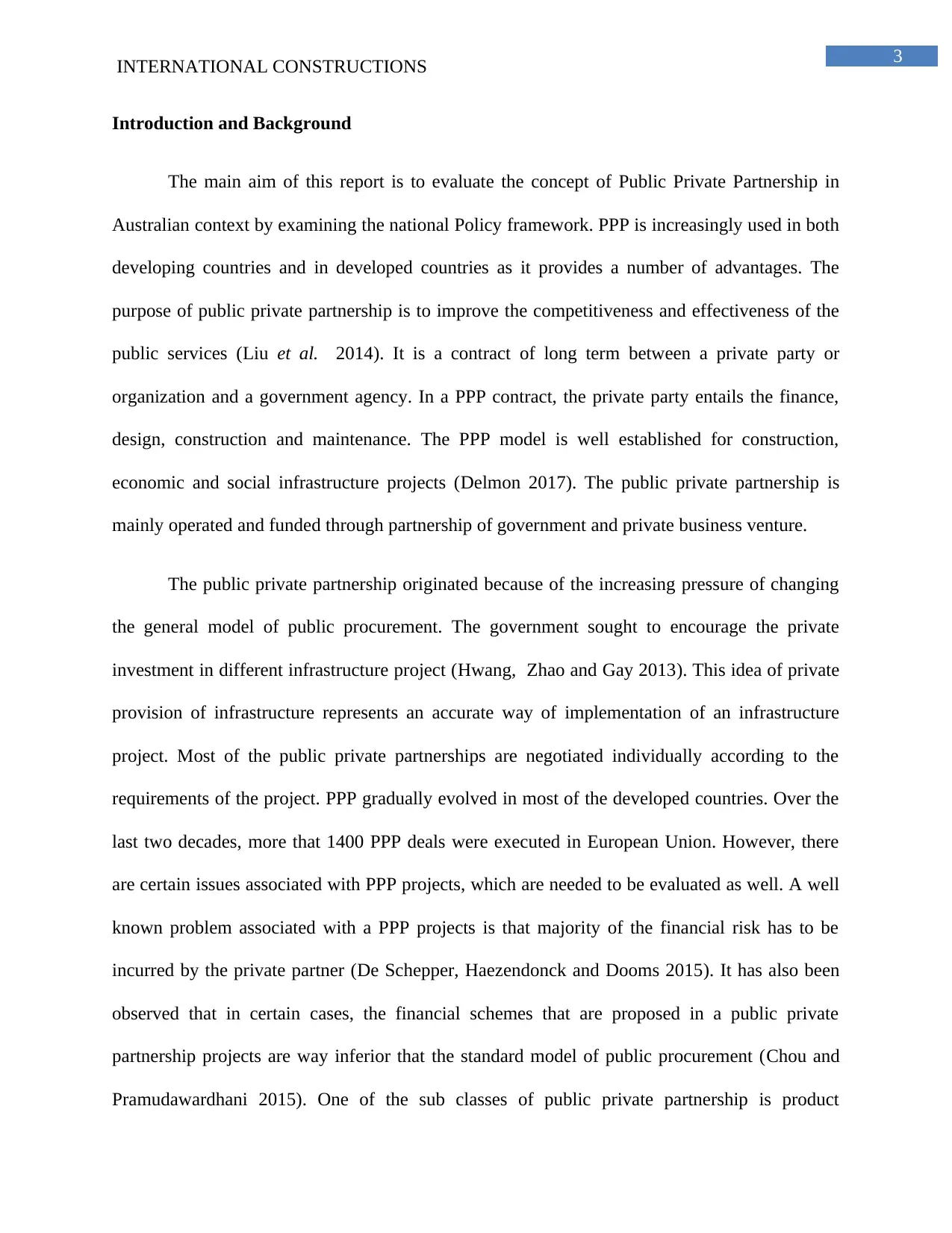
3
INTERNATIONAL CONSTRUCTIONS
Introduction and Background
The main aim of this report is to evaluate the concept of Public Private Partnership in
Australian context by examining the national Policy framework. PPP is increasingly used in both
developing countries and in developed countries as it provides a number of advantages. The
purpose of public private partnership is to improve the competitiveness and effectiveness of the
public services (Liu et al. 2014). It is a contract of long term between a private party or
organization and a government agency. In a PPP contract, the private party entails the finance,
design, construction and maintenance. The PPP model is well established for construction,
economic and social infrastructure projects (Delmon 2017). The public private partnership is
mainly operated and funded through partnership of government and private business venture.
The public private partnership originated because of the increasing pressure of changing
the general model of public procurement. The government sought to encourage the private
investment in different infrastructure project (Hwang, Zhao and Gay 2013). This idea of private
provision of infrastructure represents an accurate way of implementation of an infrastructure
project. Most of the public private partnerships are negotiated individually according to the
requirements of the project. PPP gradually evolved in most of the developed countries. Over the
last two decades, more that 1400 PPP deals were executed in European Union. However, there
are certain issues associated with PPP projects, which are needed to be evaluated as well. A well
known problem associated with a PPP projects is that majority of the financial risk has to be
incurred by the private partner (De Schepper, Haezendonck and Dooms 2015). It has also been
observed that in certain cases, the financial schemes that are proposed in a public private
partnership projects are way inferior that the standard model of public procurement (Chou and
Pramudawardhani 2015). One of the sub classes of public private partnership is product
INTERNATIONAL CONSTRUCTIONS
Introduction and Background
The main aim of this report is to evaluate the concept of Public Private Partnership in
Australian context by examining the national Policy framework. PPP is increasingly used in both
developing countries and in developed countries as it provides a number of advantages. The
purpose of public private partnership is to improve the competitiveness and effectiveness of the
public services (Liu et al. 2014). It is a contract of long term between a private party or
organization and a government agency. In a PPP contract, the private party entails the finance,
design, construction and maintenance. The PPP model is well established for construction,
economic and social infrastructure projects (Delmon 2017). The public private partnership is
mainly operated and funded through partnership of government and private business venture.
The public private partnership originated because of the increasing pressure of changing
the general model of public procurement. The government sought to encourage the private
investment in different infrastructure project (Hwang, Zhao and Gay 2013). This idea of private
provision of infrastructure represents an accurate way of implementation of an infrastructure
project. Most of the public private partnerships are negotiated individually according to the
requirements of the project. PPP gradually evolved in most of the developed countries. Over the
last two decades, more that 1400 PPP deals were executed in European Union. However, there
are certain issues associated with PPP projects, which are needed to be evaluated as well. A well
known problem associated with a PPP projects is that majority of the financial risk has to be
incurred by the private partner (De Schepper, Haezendonck and Dooms 2015). It has also been
observed that in certain cases, the financial schemes that are proposed in a public private
partnership projects are way inferior that the standard model of public procurement (Chou and
Pramudawardhani 2015). One of the sub classes of public private partnership is product
Paraphrase This Document
Need a fresh take? Get an instant paraphrase of this document with our AI Paraphraser
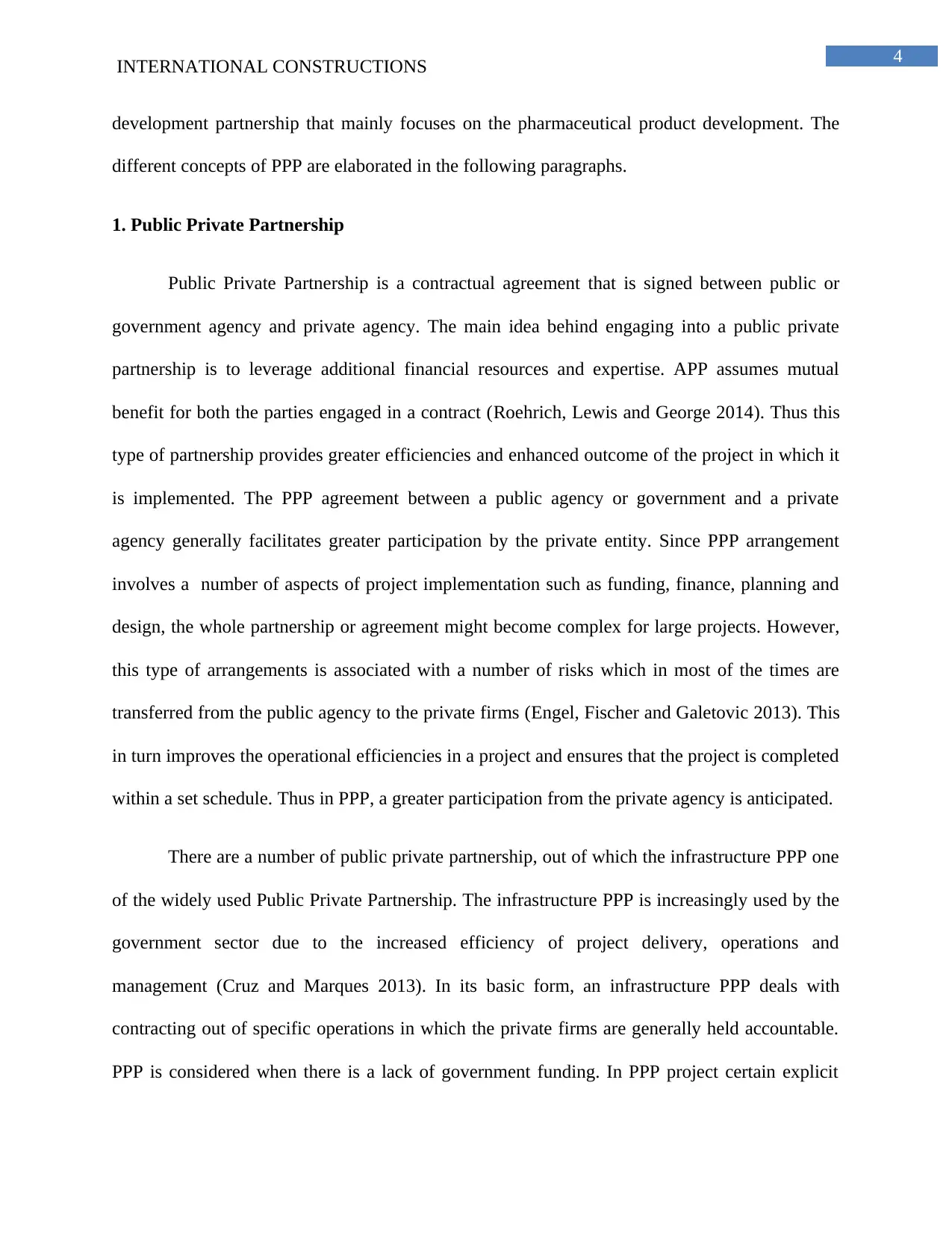
4
INTERNATIONAL CONSTRUCTIONS
development partnership that mainly focuses on the pharmaceutical product development. The
different concepts of PPP are elaborated in the following paragraphs.
1. Public Private Partnership
Public Private Partnership is a contractual agreement that is signed between public or
government agency and private agency. The main idea behind engaging into a public private
partnership is to leverage additional financial resources and expertise. APP assumes mutual
benefit for both the parties engaged in a contract (Roehrich, Lewis and George 2014). Thus this
type of partnership provides greater efficiencies and enhanced outcome of the project in which it
is implemented. The PPP agreement between a public agency or government and a private
agency generally facilitates greater participation by the private entity. Since PPP arrangement
involves a number of aspects of project implementation such as funding, finance, planning and
design, the whole partnership or agreement might become complex for large projects. However,
this type of arrangements is associated with a number of risks which in most of the times are
transferred from the public agency to the private firms (Engel, Fischer and Galetovic 2013). This
in turn improves the operational efficiencies in a project and ensures that the project is completed
within a set schedule. Thus in PPP, a greater participation from the private agency is anticipated.
There are a number of public private partnership, out of which the infrastructure PPP one
of the widely used Public Private Partnership. The infrastructure PPP is increasingly used by the
government sector due to the increased efficiency of project delivery, operations and
management (Cruz and Marques 2013). In its basic form, an infrastructure PPP deals with
contracting out of specific operations in which the private firms are generally held accountable.
PPP is considered when there is a lack of government funding. In PPP project certain explicit
INTERNATIONAL CONSTRUCTIONS
development partnership that mainly focuses on the pharmaceutical product development. The
different concepts of PPP are elaborated in the following paragraphs.
1. Public Private Partnership
Public Private Partnership is a contractual agreement that is signed between public or
government agency and private agency. The main idea behind engaging into a public private
partnership is to leverage additional financial resources and expertise. APP assumes mutual
benefit for both the parties engaged in a contract (Roehrich, Lewis and George 2014). Thus this
type of partnership provides greater efficiencies and enhanced outcome of the project in which it
is implemented. The PPP agreement between a public agency or government and a private
agency generally facilitates greater participation by the private entity. Since PPP arrangement
involves a number of aspects of project implementation such as funding, finance, planning and
design, the whole partnership or agreement might become complex for large projects. However,
this type of arrangements is associated with a number of risks which in most of the times are
transferred from the public agency to the private firms (Engel, Fischer and Galetovic 2013). This
in turn improves the operational efficiencies in a project and ensures that the project is completed
within a set schedule. Thus in PPP, a greater participation from the private agency is anticipated.
There are a number of public private partnership, out of which the infrastructure PPP one
of the widely used Public Private Partnership. The infrastructure PPP is increasingly used by the
government sector due to the increased efficiency of project delivery, operations and
management (Cruz and Marques 2013). In its basic form, an infrastructure PPP deals with
contracting out of specific operations in which the private firms are generally held accountable.
PPP is considered when there is a lack of government funding. In PPP project certain explicit
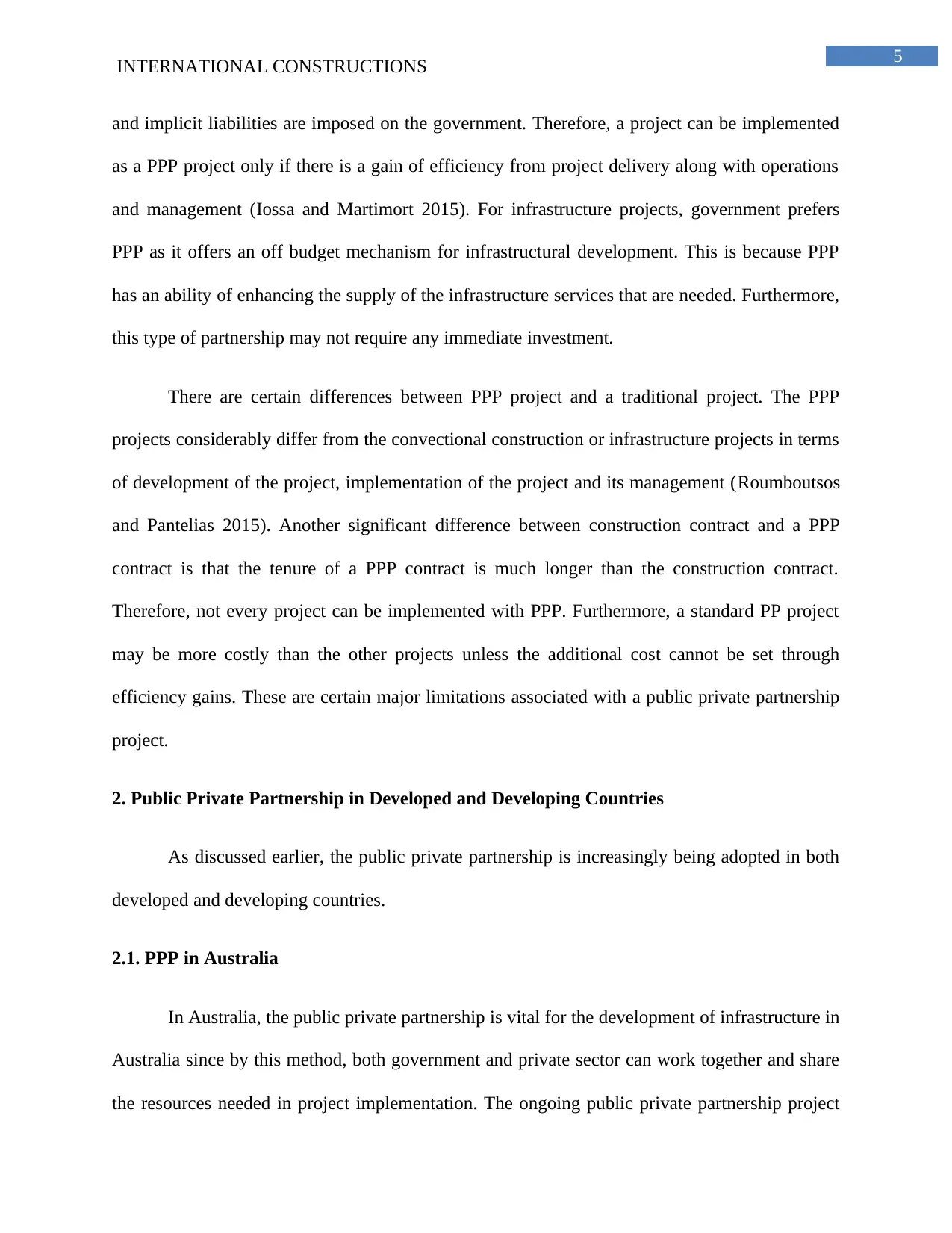
5
INTERNATIONAL CONSTRUCTIONS
and implicit liabilities are imposed on the government. Therefore, a project can be implemented
as a PPP project only if there is a gain of efficiency from project delivery along with operations
and management (Iossa and Martimort 2015). For infrastructure projects, government prefers
PPP as it offers an off budget mechanism for infrastructural development. This is because PPP
has an ability of enhancing the supply of the infrastructure services that are needed. Furthermore,
this type of partnership may not require any immediate investment.
There are certain differences between PPP project and a traditional project. The PPP
projects considerably differ from the convectional construction or infrastructure projects in terms
of development of the project, implementation of the project and its management (Roumboutsos
and Pantelias 2015). Another significant difference between construction contract and a PPP
contract is that the tenure of a PPP contract is much longer than the construction contract.
Therefore, not every project can be implemented with PPP. Furthermore, a standard PP project
may be more costly than the other projects unless the additional cost cannot be set through
efficiency gains. These are certain major limitations associated with a public private partnership
project.
2. Public Private Partnership in Developed and Developing Countries
As discussed earlier, the public private partnership is increasingly being adopted in both
developed and developing countries.
2.1. PPP in Australia
In Australia, the public private partnership is vital for the development of infrastructure in
Australia since by this method, both government and private sector can work together and share
the resources needed in project implementation. The ongoing public private partnership project
INTERNATIONAL CONSTRUCTIONS
and implicit liabilities are imposed on the government. Therefore, a project can be implemented
as a PPP project only if there is a gain of efficiency from project delivery along with operations
and management (Iossa and Martimort 2015). For infrastructure projects, government prefers
PPP as it offers an off budget mechanism for infrastructural development. This is because PPP
has an ability of enhancing the supply of the infrastructure services that are needed. Furthermore,
this type of partnership may not require any immediate investment.
There are certain differences between PPP project and a traditional project. The PPP
projects considerably differ from the convectional construction or infrastructure projects in terms
of development of the project, implementation of the project and its management (Roumboutsos
and Pantelias 2015). Another significant difference between construction contract and a PPP
contract is that the tenure of a PPP contract is much longer than the construction contract.
Therefore, not every project can be implemented with PPP. Furthermore, a standard PP project
may be more costly than the other projects unless the additional cost cannot be set through
efficiency gains. These are certain major limitations associated with a public private partnership
project.
2. Public Private Partnership in Developed and Developing Countries
As discussed earlier, the public private partnership is increasingly being adopted in both
developed and developing countries.
2.1. PPP in Australia
In Australia, the public private partnership is vital for the development of infrastructure in
Australia since by this method, both government and private sector can work together and share
the resources needed in project implementation. The ongoing public private partnership project
⊘ This is a preview!⊘
Do you want full access?
Subscribe today to unlock all pages.

Trusted by 1+ million students worldwide
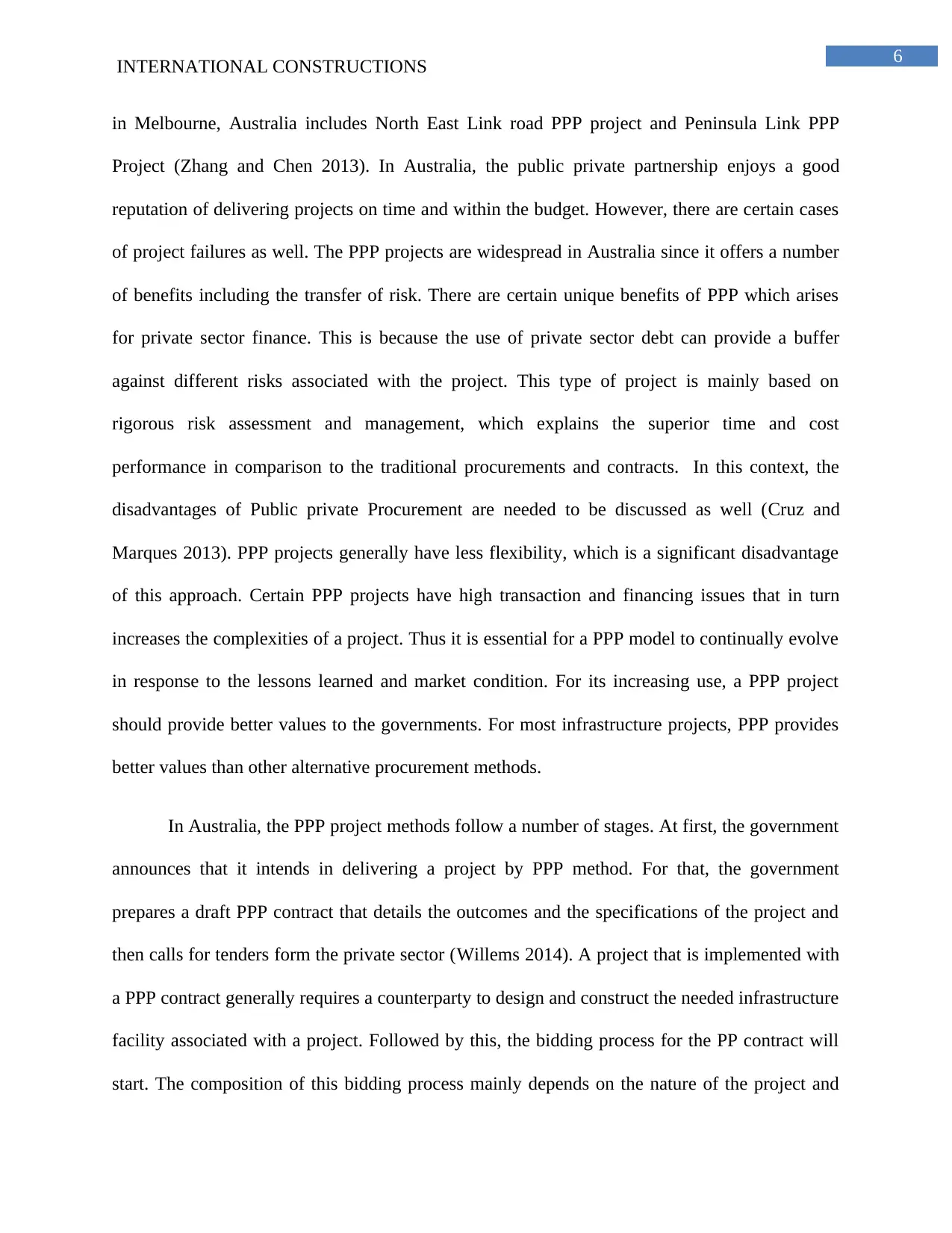
6
INTERNATIONAL CONSTRUCTIONS
in Melbourne, Australia includes North East Link road PPP project and Peninsula Link PPP
Project (Zhang and Chen 2013). In Australia, the public private partnership enjoys a good
reputation of delivering projects on time and within the budget. However, there are certain cases
of project failures as well. The PPP projects are widespread in Australia since it offers a number
of benefits including the transfer of risk. There are certain unique benefits of PPP which arises
for private sector finance. This is because the use of private sector debt can provide a buffer
against different risks associated with the project. This type of project is mainly based on
rigorous risk assessment and management, which explains the superior time and cost
performance in comparison to the traditional procurements and contracts. In this context, the
disadvantages of Public private Procurement are needed to be discussed as well (Cruz and
Marques 2013). PPP projects generally have less flexibility, which is a significant disadvantage
of this approach. Certain PPP projects have high transaction and financing issues that in turn
increases the complexities of a project. Thus it is essential for a PPP model to continually evolve
in response to the lessons learned and market condition. For its increasing use, a PPP project
should provide better values to the governments. For most infrastructure projects, PPP provides
better values than other alternative procurement methods.
In Australia, the PPP project methods follow a number of stages. At first, the government
announces that it intends in delivering a project by PPP method. For that, the government
prepares a draft PPP contract that details the outcomes and the specifications of the project and
then calls for tenders form the private sector (Willems 2014). A project that is implemented with
a PPP contract generally requires a counterparty to design and construct the needed infrastructure
facility associated with a project. Followed by this, the bidding process for the PP contract will
start. The composition of this bidding process mainly depends on the nature of the project and
INTERNATIONAL CONSTRUCTIONS
in Melbourne, Australia includes North East Link road PPP project and Peninsula Link PPP
Project (Zhang and Chen 2013). In Australia, the public private partnership enjoys a good
reputation of delivering projects on time and within the budget. However, there are certain cases
of project failures as well. The PPP projects are widespread in Australia since it offers a number
of benefits including the transfer of risk. There are certain unique benefits of PPP which arises
for private sector finance. This is because the use of private sector debt can provide a buffer
against different risks associated with the project. This type of project is mainly based on
rigorous risk assessment and management, which explains the superior time and cost
performance in comparison to the traditional procurements and contracts. In this context, the
disadvantages of Public private Procurement are needed to be discussed as well (Cruz and
Marques 2013). PPP projects generally have less flexibility, which is a significant disadvantage
of this approach. Certain PPP projects have high transaction and financing issues that in turn
increases the complexities of a project. Thus it is essential for a PPP model to continually evolve
in response to the lessons learned and market condition. For its increasing use, a PPP project
should provide better values to the governments. For most infrastructure projects, PPP provides
better values than other alternative procurement methods.
In Australia, the PPP project methods follow a number of stages. At first, the government
announces that it intends in delivering a project by PPP method. For that, the government
prepares a draft PPP contract that details the outcomes and the specifications of the project and
then calls for tenders form the private sector (Willems 2014). A project that is implemented with
a PPP contract generally requires a counterparty to design and construct the needed infrastructure
facility associated with a project. Followed by this, the bidding process for the PP contract will
start. The composition of this bidding process mainly depends on the nature of the project and
Paraphrase This Document
Need a fresh take? Get an instant paraphrase of this document with our AI Paraphraser
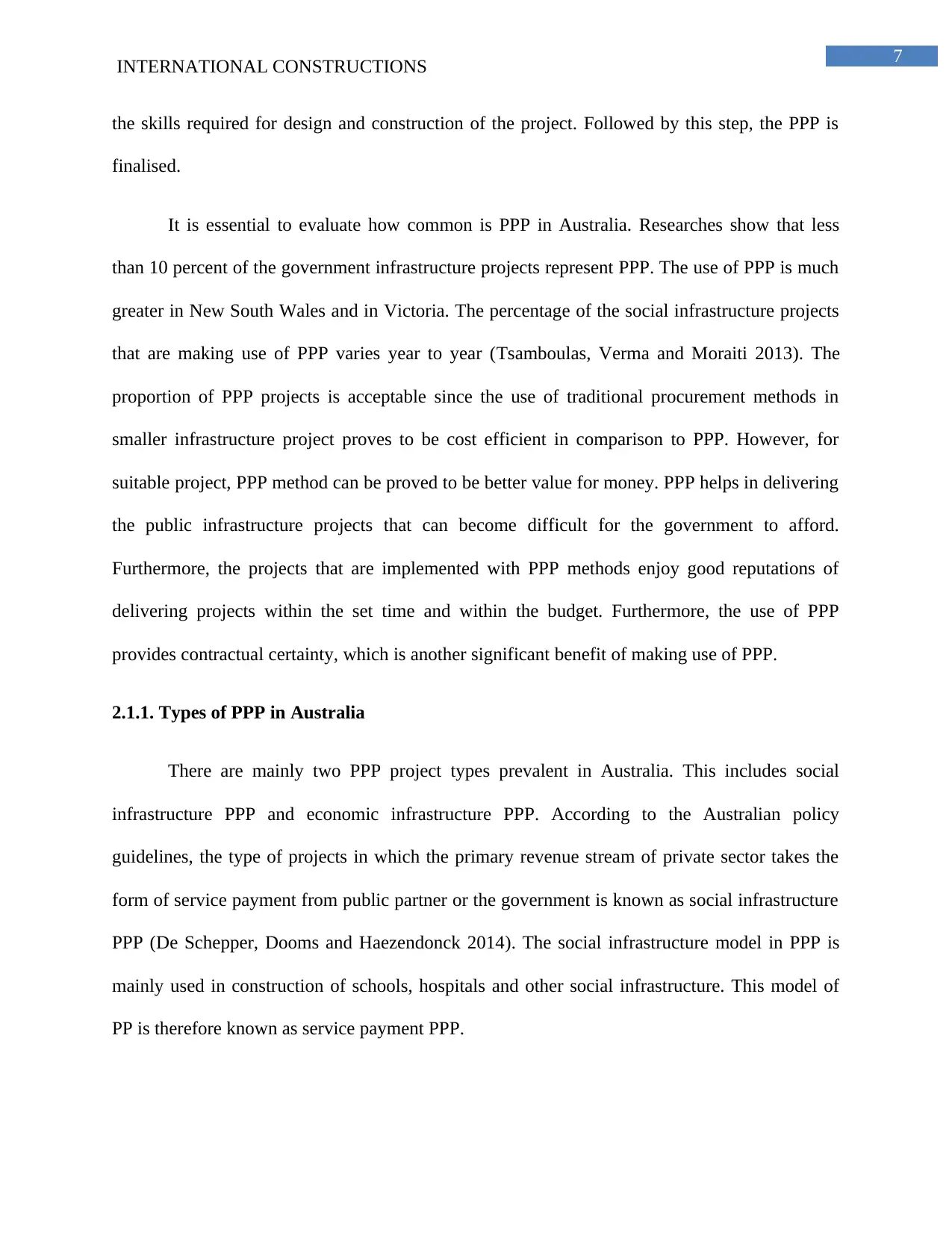
7
INTERNATIONAL CONSTRUCTIONS
the skills required for design and construction of the project. Followed by this step, the PPP is
finalised.
It is essential to evaluate how common is PPP in Australia. Researches show that less
than 10 percent of the government infrastructure projects represent PPP. The use of PPP is much
greater in New South Wales and in Victoria. The percentage of the social infrastructure projects
that are making use of PPP varies year to year (Tsamboulas, Verma and Moraiti 2013). The
proportion of PPP projects is acceptable since the use of traditional procurement methods in
smaller infrastructure project proves to be cost efficient in comparison to PPP. However, for
suitable project, PPP method can be proved to be better value for money. PPP helps in delivering
the public infrastructure projects that can become difficult for the government to afford.
Furthermore, the projects that are implemented with PPP methods enjoy good reputations of
delivering projects within the set time and within the budget. Furthermore, the use of PPP
provides contractual certainty, which is another significant benefit of making use of PPP.
2.1.1. Types of PPP in Australia
There are mainly two PPP project types prevalent in Australia. This includes social
infrastructure PPP and economic infrastructure PPP. According to the Australian policy
guidelines, the type of projects in which the primary revenue stream of private sector takes the
form of service payment from public partner or the government is known as social infrastructure
PPP (De Schepper, Dooms and Haezendonck 2014). The social infrastructure model in PPP is
mainly used in construction of schools, hospitals and other social infrastructure. This model of
PP is therefore known as service payment PPP.
INTERNATIONAL CONSTRUCTIONS
the skills required for design and construction of the project. Followed by this step, the PPP is
finalised.
It is essential to evaluate how common is PPP in Australia. Researches show that less
than 10 percent of the government infrastructure projects represent PPP. The use of PPP is much
greater in New South Wales and in Victoria. The percentage of the social infrastructure projects
that are making use of PPP varies year to year (Tsamboulas, Verma and Moraiti 2013). The
proportion of PPP projects is acceptable since the use of traditional procurement methods in
smaller infrastructure project proves to be cost efficient in comparison to PPP. However, for
suitable project, PPP method can be proved to be better value for money. PPP helps in delivering
the public infrastructure projects that can become difficult for the government to afford.
Furthermore, the projects that are implemented with PPP methods enjoy good reputations of
delivering projects within the set time and within the budget. Furthermore, the use of PPP
provides contractual certainty, which is another significant benefit of making use of PPP.
2.1.1. Types of PPP in Australia
There are mainly two PPP project types prevalent in Australia. This includes social
infrastructure PPP and economic infrastructure PPP. According to the Australian policy
guidelines, the type of projects in which the primary revenue stream of private sector takes the
form of service payment from public partner or the government is known as social infrastructure
PPP (De Schepper, Dooms and Haezendonck 2014). The social infrastructure model in PPP is
mainly used in construction of schools, hospitals and other social infrastructure. This model of
PP is therefore known as service payment PPP.
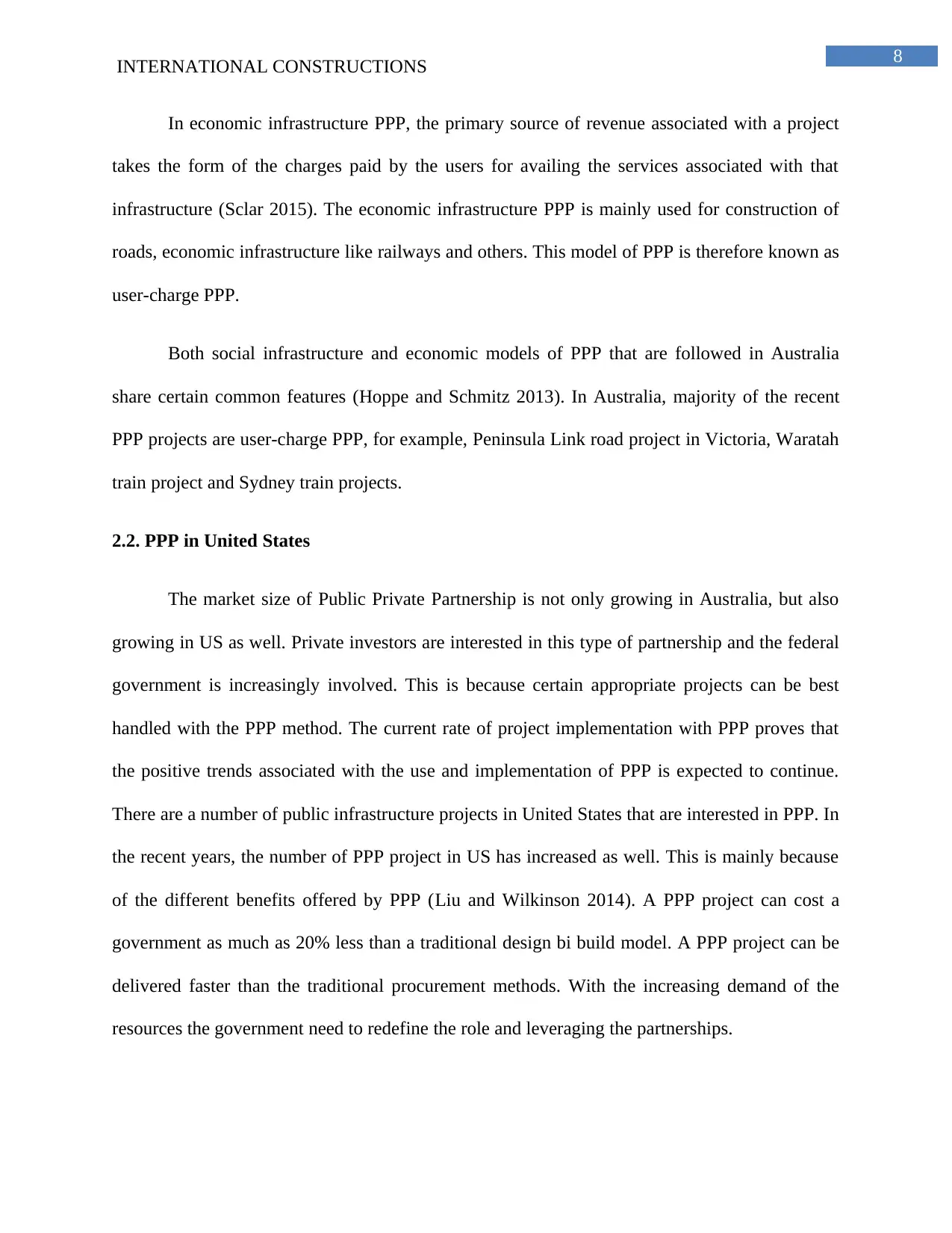
8
INTERNATIONAL CONSTRUCTIONS
In economic infrastructure PPP, the primary source of revenue associated with a project
takes the form of the charges paid by the users for availing the services associated with that
infrastructure (Sclar 2015). The economic infrastructure PPP is mainly used for construction of
roads, economic infrastructure like railways and others. This model of PPP is therefore known as
user-charge PPP.
Both social infrastructure and economic models of PPP that are followed in Australia
share certain common features (Hoppe and Schmitz 2013). In Australia, majority of the recent
PPP projects are user-charge PPP, for example, Peninsula Link road project in Victoria, Waratah
train project and Sydney train projects.
2.2. PPP in United States
The market size of Public Private Partnership is not only growing in Australia, but also
growing in US as well. Private investors are interested in this type of partnership and the federal
government is increasingly involved. This is because certain appropriate projects can be best
handled with the PPP method. The current rate of project implementation with PPP proves that
the positive trends associated with the use and implementation of PPP is expected to continue.
There are a number of public infrastructure projects in United States that are interested in PPP. In
the recent years, the number of PPP project in US has increased as well. This is mainly because
of the different benefits offered by PPP (Liu and Wilkinson 2014). A PPP project can cost a
government as much as 20% less than a traditional design bi build model. A PPP project can be
delivered faster than the traditional procurement methods. With the increasing demand of the
resources the government need to redefine the role and leveraging the partnerships.
INTERNATIONAL CONSTRUCTIONS
In economic infrastructure PPP, the primary source of revenue associated with a project
takes the form of the charges paid by the users for availing the services associated with that
infrastructure (Sclar 2015). The economic infrastructure PPP is mainly used for construction of
roads, economic infrastructure like railways and others. This model of PPP is therefore known as
user-charge PPP.
Both social infrastructure and economic models of PPP that are followed in Australia
share certain common features (Hoppe and Schmitz 2013). In Australia, majority of the recent
PPP projects are user-charge PPP, for example, Peninsula Link road project in Victoria, Waratah
train project and Sydney train projects.
2.2. PPP in United States
The market size of Public Private Partnership is not only growing in Australia, but also
growing in US as well. Private investors are interested in this type of partnership and the federal
government is increasingly involved. This is because certain appropriate projects can be best
handled with the PPP method. The current rate of project implementation with PPP proves that
the positive trends associated with the use and implementation of PPP is expected to continue.
There are a number of public infrastructure projects in United States that are interested in PPP. In
the recent years, the number of PPP project in US has increased as well. This is mainly because
of the different benefits offered by PPP (Liu and Wilkinson 2014). A PPP project can cost a
government as much as 20% less than a traditional design bi build model. A PPP project can be
delivered faster than the traditional procurement methods. With the increasing demand of the
resources the government need to redefine the role and leveraging the partnerships.
⊘ This is a preview!⊘
Do you want full access?
Subscribe today to unlock all pages.

Trusted by 1+ million students worldwide
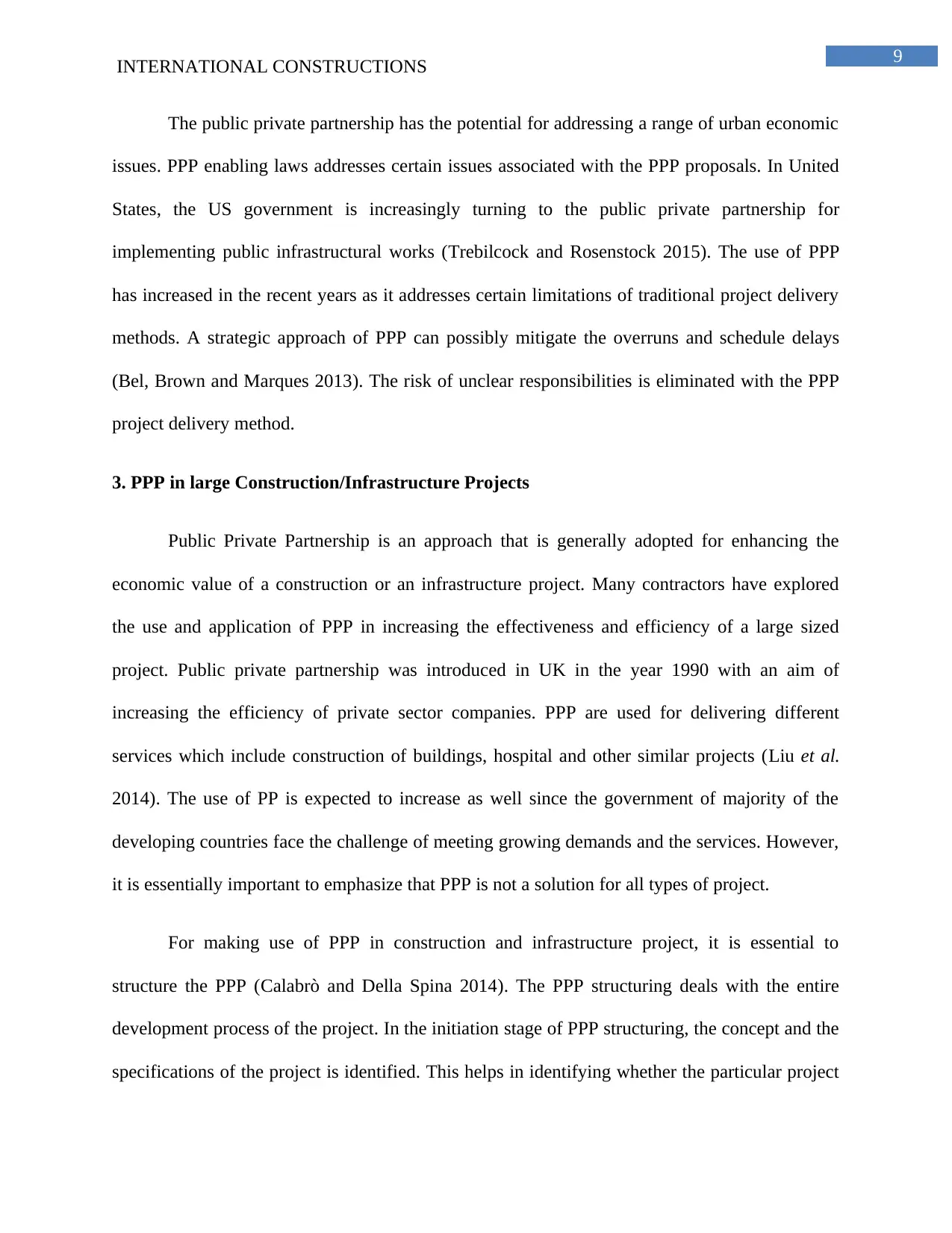
9
INTERNATIONAL CONSTRUCTIONS
The public private partnership has the potential for addressing a range of urban economic
issues. PPP enabling laws addresses certain issues associated with the PPP proposals. In United
States, the US government is increasingly turning to the public private partnership for
implementing public infrastructural works (Trebilcock and Rosenstock 2015). The use of PPP
has increased in the recent years as it addresses certain limitations of traditional project delivery
methods. A strategic approach of PPP can possibly mitigate the overruns and schedule delays
(Bel, Brown and Marques 2013). The risk of unclear responsibilities is eliminated with the PPP
project delivery method.
3. PPP in large Construction/Infrastructure Projects
Public Private Partnership is an approach that is generally adopted for enhancing the
economic value of a construction or an infrastructure project. Many contractors have explored
the use and application of PPP in increasing the effectiveness and efficiency of a large sized
project. Public private partnership was introduced in UK in the year 1990 with an aim of
increasing the efficiency of private sector companies. PPP are used for delivering different
services which include construction of buildings, hospital and other similar projects (Liu et al.
2014). The use of PP is expected to increase as well since the government of majority of the
developing countries face the challenge of meeting growing demands and the services. However,
it is essentially important to emphasize that PPP is not a solution for all types of project.
For making use of PPP in construction and infrastructure project, it is essential to
structure the PPP (Calabrò and Della Spina 2014). The PPP structuring deals with the entire
development process of the project. In the initiation stage of PPP structuring, the concept and the
specifications of the project is identified. This helps in identifying whether the particular project
INTERNATIONAL CONSTRUCTIONS
The public private partnership has the potential for addressing a range of urban economic
issues. PPP enabling laws addresses certain issues associated with the PPP proposals. In United
States, the US government is increasingly turning to the public private partnership for
implementing public infrastructural works (Trebilcock and Rosenstock 2015). The use of PPP
has increased in the recent years as it addresses certain limitations of traditional project delivery
methods. A strategic approach of PPP can possibly mitigate the overruns and schedule delays
(Bel, Brown and Marques 2013). The risk of unclear responsibilities is eliminated with the PPP
project delivery method.
3. PPP in large Construction/Infrastructure Projects
Public Private Partnership is an approach that is generally adopted for enhancing the
economic value of a construction or an infrastructure project. Many contractors have explored
the use and application of PPP in increasing the effectiveness and efficiency of a large sized
project. Public private partnership was introduced in UK in the year 1990 with an aim of
increasing the efficiency of private sector companies. PPP are used for delivering different
services which include construction of buildings, hospital and other similar projects (Liu et al.
2014). The use of PP is expected to increase as well since the government of majority of the
developing countries face the challenge of meeting growing demands and the services. However,
it is essentially important to emphasize that PPP is not a solution for all types of project.
For making use of PPP in construction and infrastructure project, it is essential to
structure the PPP (Calabrò and Della Spina 2014). The PPP structuring deals with the entire
development process of the project. In the initiation stage of PPP structuring, the concept and the
specifications of the project is identified. This helps in identifying whether the particular project
Paraphrase This Document
Need a fresh take? Get an instant paraphrase of this document with our AI Paraphraser
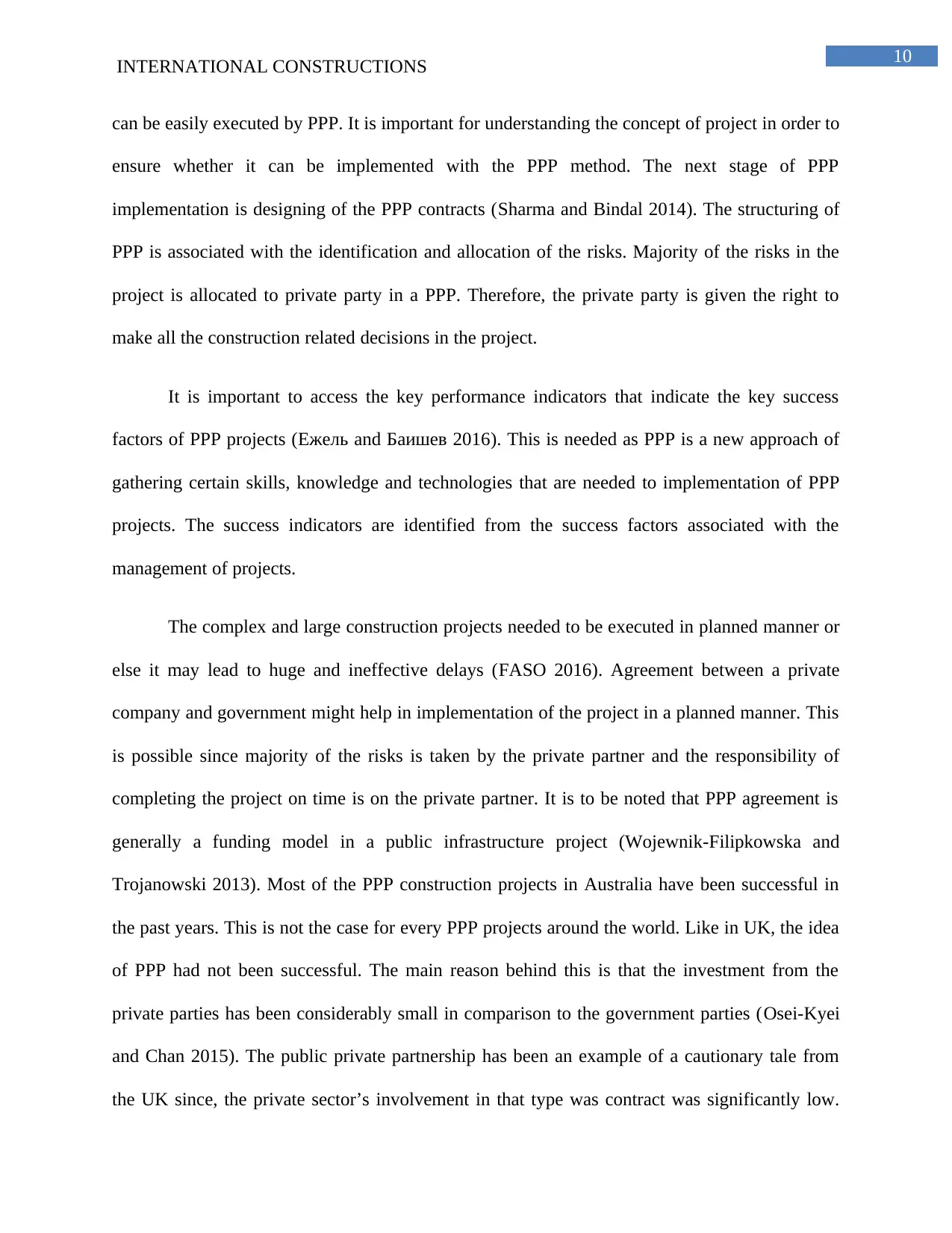
10
INTERNATIONAL CONSTRUCTIONS
can be easily executed by PPP. It is important for understanding the concept of project in order to
ensure whether it can be implemented with the PPP method. The next stage of PPP
implementation is designing of the PPP contracts (Sharma and Bindal 2014). The structuring of
PPP is associated with the identification and allocation of the risks. Majority of the risks in the
project is allocated to private party in a PPP. Therefore, the private party is given the right to
make all the construction related decisions in the project.
It is important to access the key performance indicators that indicate the key success
factors of PPP projects (Ежель and Баишев 2016). This is needed as PPP is a new approach of
gathering certain skills, knowledge and technologies that are needed to implementation of PPP
projects. The success indicators are identified from the success factors associated with the
management of projects.
The complex and large construction projects needed to be executed in planned manner or
else it may lead to huge and ineffective delays (FASO 2016). Agreement between a private
company and government might help in implementation of the project in a planned manner. This
is possible since majority of the risks is taken by the private partner and the responsibility of
completing the project on time is on the private partner. It is to be noted that PPP agreement is
generally a funding model in a public infrastructure project (Wojewnik-Filipkowska and
Trojanowski 2013). Most of the PPP construction projects in Australia have been successful in
the past years. This is not the case for every PPP projects around the world. Like in UK, the idea
of PPP had not been successful. The main reason behind this is that the investment from the
private parties has been considerably small in comparison to the government parties (Osei-Kyei
and Chan 2015). The public private partnership has been an example of a cautionary tale from
the UK since, the private sector’s involvement in that type was contract was significantly low.
INTERNATIONAL CONSTRUCTIONS
can be easily executed by PPP. It is important for understanding the concept of project in order to
ensure whether it can be implemented with the PPP method. The next stage of PPP
implementation is designing of the PPP contracts (Sharma and Bindal 2014). The structuring of
PPP is associated with the identification and allocation of the risks. Majority of the risks in the
project is allocated to private party in a PPP. Therefore, the private party is given the right to
make all the construction related decisions in the project.
It is important to access the key performance indicators that indicate the key success
factors of PPP projects (Ежель and Баишев 2016). This is needed as PPP is a new approach of
gathering certain skills, knowledge and technologies that are needed to implementation of PPP
projects. The success indicators are identified from the success factors associated with the
management of projects.
The complex and large construction projects needed to be executed in planned manner or
else it may lead to huge and ineffective delays (FASO 2016). Agreement between a private
company and government might help in implementation of the project in a planned manner. This
is possible since majority of the risks is taken by the private partner and the responsibility of
completing the project on time is on the private partner. It is to be noted that PPP agreement is
generally a funding model in a public infrastructure project (Wojewnik-Filipkowska and
Trojanowski 2013). Most of the PPP construction projects in Australia have been successful in
the past years. This is not the case for every PPP projects around the world. Like in UK, the idea
of PPP had not been successful. The main reason behind this is that the investment from the
private parties has been considerably small in comparison to the government parties (Osei-Kyei
and Chan 2015). The public private partnership has been an example of a cautionary tale from
the UK since, the private sector’s involvement in that type was contract was significantly low.
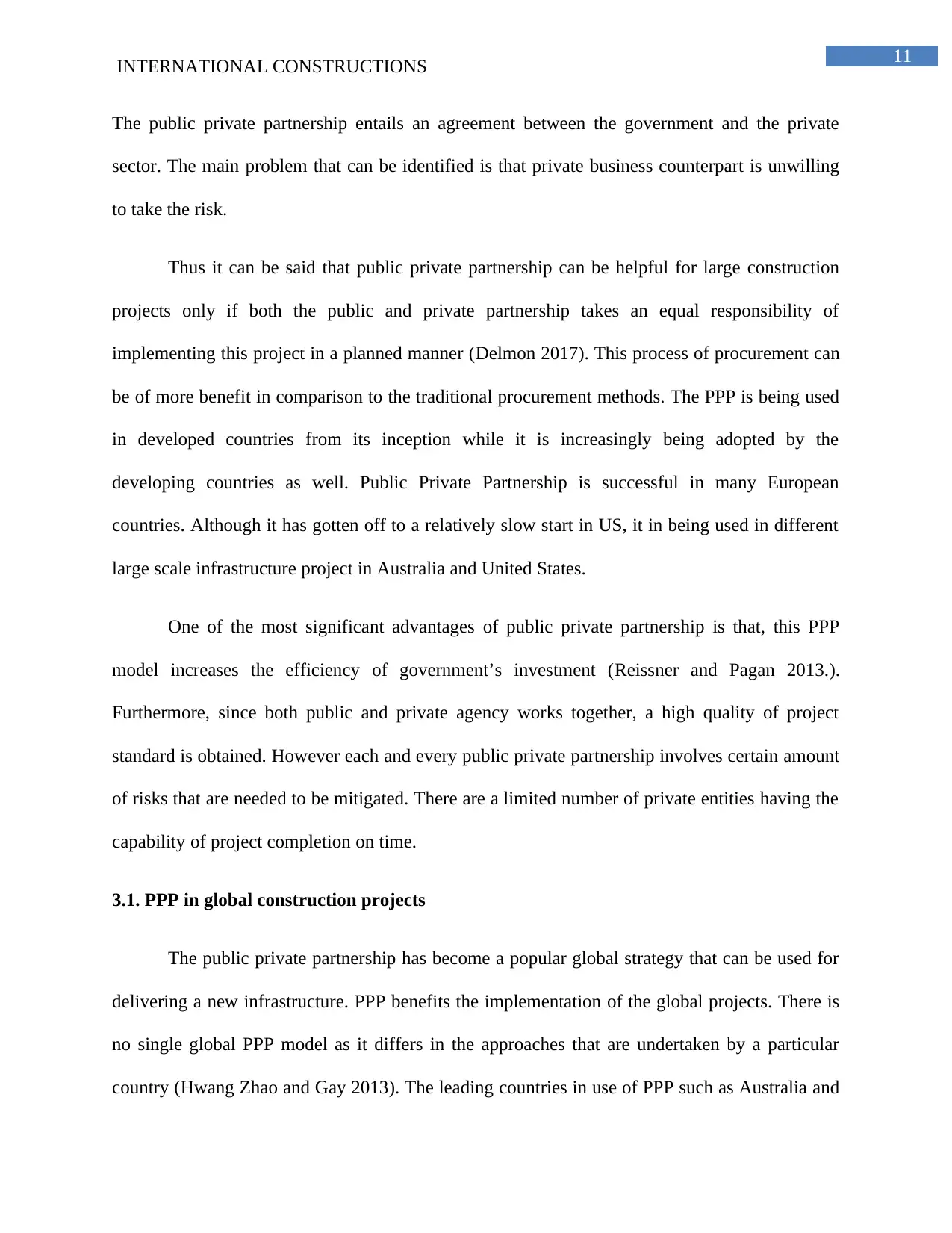
11
INTERNATIONAL CONSTRUCTIONS
The public private partnership entails an agreement between the government and the private
sector. The main problem that can be identified is that private business counterpart is unwilling
to take the risk.
Thus it can be said that public private partnership can be helpful for large construction
projects only if both the public and private partnership takes an equal responsibility of
implementing this project in a planned manner (Delmon 2017). This process of procurement can
be of more benefit in comparison to the traditional procurement methods. The PPP is being used
in developed countries from its inception while it is increasingly being adopted by the
developing countries as well. Public Private Partnership is successful in many European
countries. Although it has gotten off to a relatively slow start in US, it in being used in different
large scale infrastructure project in Australia and United States.
One of the most significant advantages of public private partnership is that, this PPP
model increases the efficiency of government’s investment (Reissner and Pagan 2013.).
Furthermore, since both public and private agency works together, a high quality of project
standard is obtained. However each and every public private partnership involves certain amount
of risks that are needed to be mitigated. There are a limited number of private entities having the
capability of project completion on time.
3.1. PPP in global construction projects
The public private partnership has become a popular global strategy that can be used for
delivering a new infrastructure. PPP benefits the implementation of the global projects. There is
no single global PPP model as it differs in the approaches that are undertaken by a particular
country (Hwang Zhao and Gay 2013). The leading countries in use of PPP such as Australia and
INTERNATIONAL CONSTRUCTIONS
The public private partnership entails an agreement between the government and the private
sector. The main problem that can be identified is that private business counterpart is unwilling
to take the risk.
Thus it can be said that public private partnership can be helpful for large construction
projects only if both the public and private partnership takes an equal responsibility of
implementing this project in a planned manner (Delmon 2017). This process of procurement can
be of more benefit in comparison to the traditional procurement methods. The PPP is being used
in developed countries from its inception while it is increasingly being adopted by the
developing countries as well. Public Private Partnership is successful in many European
countries. Although it has gotten off to a relatively slow start in US, it in being used in different
large scale infrastructure project in Australia and United States.
One of the most significant advantages of public private partnership is that, this PPP
model increases the efficiency of government’s investment (Reissner and Pagan 2013.).
Furthermore, since both public and private agency works together, a high quality of project
standard is obtained. However each and every public private partnership involves certain amount
of risks that are needed to be mitigated. There are a limited number of private entities having the
capability of project completion on time.
3.1. PPP in global construction projects
The public private partnership has become a popular global strategy that can be used for
delivering a new infrastructure. PPP benefits the implementation of the global projects. There is
no single global PPP model as it differs in the approaches that are undertaken by a particular
country (Hwang Zhao and Gay 2013). The leading countries in use of PPP such as Australia and
⊘ This is a preview!⊘
Do you want full access?
Subscribe today to unlock all pages.

Trusted by 1+ million students worldwide
1 out of 19
Related Documents
Your All-in-One AI-Powered Toolkit for Academic Success.
+13062052269
info@desklib.com
Available 24*7 on WhatsApp / Email
![[object Object]](/_next/static/media/star-bottom.7253800d.svg)
Unlock your academic potential
Copyright © 2020–2025 A2Z Services. All Rights Reserved. Developed and managed by ZUCOL.





